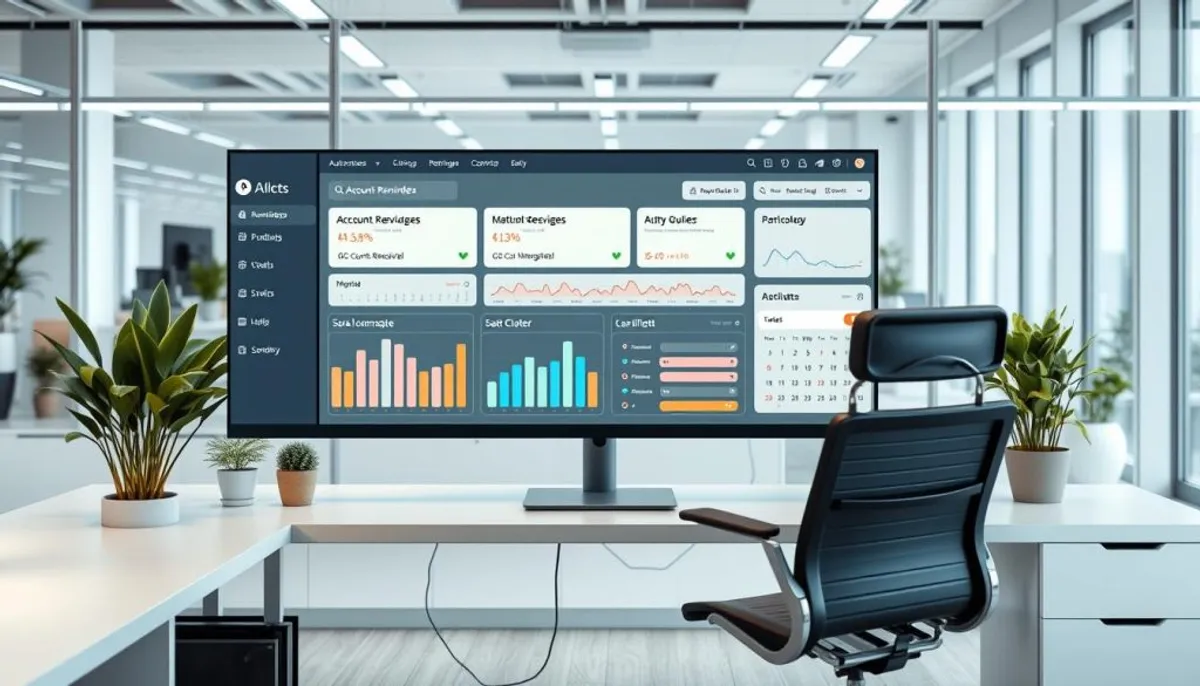In today’s fast-paced business world, efficiently managing accounts receivable is essential for success. Accounts receivable solutions introduce a transformative approach to invoice automation and payment processing. These tools help businesses overcome common challenges such as late payments, invoice disputes, and time-consuming manual processes.
Implementing advanced accounts receivable solutions can significantly enhance a company’s cash flow and customer relationships. For example, Centime’s AR automation optimizes workflows, reducing overdue payments and boosting working capital. Tesorio leverages machine learning for accurate cash forecasting, while HighRadius offers AI-driven finance solutions for businesses of all sizes.

The advantages of these solutions are evident. They minimize manual data entry errors, streamline cash posting, and enable real-time credit risk monitoring. With features like AI-driven worklist prioritization and automated collections, businesses can focus on growth rather than chasing payments.
Key Takeaways
- AR solutions address late payments and invoice disputes
- Automation reduces manual errors and administrative burden
- AI-driven tools improve cash forecasting and collections
- Real-time monitoring enhances credit risk assessment
- Streamlined processes boost cash flow and customer relations
Understanding Accounts Receivable Management Fundamentals
Accounts receivable management is crucial for businesses to maintain a positive cash flow. It involves tracking money owed by clients through billing, invoicing, and collections management. Let’s explore the essential components of this vital business function.
Defining AR Management and Its Importance
Accounts receivable (AR) is the money owed by customers for services rendered. Effective AR management is key to optimizing cash flow and financial health. By clearly communicating pricing and payment terms upfront, businesses can lower late payments and disputes.
Core Components of AR Operations
Timely invoicing is central to AR operations. Detailed invoices reduce confusion and increase the likelihood of prompt payment. Offering various payment options, like credit card terminals and online portals, aids in collections. Internal follow-ups for unpaid invoices are vital for maintaining healthy cash flow.
Impact on Business Cash Flow
Late payments from customers are a major cause of cash flow issues. Implementing robust credit management practices can greatly enhance a company’s financial stability. For example, Apple Inc. achieved a remarkable accounts receivable turnover ratio of 13.2 in Q4 2021, highlighting efficient collections management. Employing strategies like clear credit policies and timely reminders can streamline the receivables process and optimize cash flow.
| Strategy | Impact on Cash Flow |
|---|---|
| Clear credit policies | Reduces payment delays |
| Multiple payment options | Increases collection speed |
| Timely reminders | Improves payment compliance |
The Evolution of Modern Accounts Receivable Solutions
The realm of accounts receivable management has undergone a profound transformation in recent years. The era of paper-based systems and manual record-keeping is now a relic of the past. Today, businesses are gravitating towards digital solutions that streamline operations and enhance efficiency.
Modern billing software has transformed the financial management landscape. These advanced systems automate the generation of invoices, tracking of payments, and reconciliation processes. This automation leads to a reduction in human errors and a significant saving of time.
Accounts receivable outsourcing has also evolved in tandem with technological advancements. Outsourcing firms now employ cutting-edge tools to deliver superior services. They utilize data analytics for deeper insights, AI for personalized collection strategies, and blockchain for enhanced security.
The transition to cloud-based AR management systems offers numerous advantages:
- Accessibility from anywhere
- Scalability to meet growing business needs
- Robust security measures to protect financial data
These developments have significantly impacted businesses. Recent statistics reveal that 93% of enterprises have encountered delayed payments from clients. Yet, with modern AR solutions, companies can better manage their cash flow and reduce bad debt write-offs, which typically account for 1.5% of receivables.
The integration of AR management with ERP systems further streamlines financial processes. This connection enhances data accuracy and provides real-time insights for informed decision-making. As technology continues to evolve, so too will the capabilities of accounts receivable solutions.
Key Benefits of Implementing AR Automation
AR automation introduces transformative advantages to enterprises. It transcends mere time-saving; it revolutionizes financial management and customer interaction.
Reduced Manual Processing Time
AR automation dramatically reduces manual labor. A study revealed that 77% of AR teams encounter delays in invoice processing. Automation enables businesses to save up to 35,000 admin hours annually. This liberation empowers staff to concentrate on strategic endeavors, enhancing overall productivity.
Enhanced Accuracy and Error Reduction
Automation significantly diminishes errors. 63% of CFOs attest to a decrease in billing inaccuracies post-AR automation. Such precision fosters smoother operations and customer satisfaction.
Improved Cash Flow Management
AR automation accelerates cash flow management. It can reduce Days Sales Outstanding (DSO) by 32%. Automated reminders and streamlined dispute resolution expedite cash receipt. This rapid access to funds enhances liquidity and financial stability.
Better Customer Relationships
Effective AR practices fortify customer relationships. 97% of C-level executives deem customer experience paramount in AR. Automation ensures prompt, accurate invoicing and effective communication. It also introduces self-service options, simplifying customer payment processes.
| Benefit | Impact |
|---|---|
| Time Savings | 35,000 admin hours/year |
| Cost Savings | $4.9 million annually |
| DSO Reduction | 32% |
| Billing Error Reduction | 63% of CFOs report improvement |
By embracing AR automation, businesses can profoundly enhance their financial operations. From minimizing manual tasks to bolstering customer relationships, the advantages are evident and substantial.
Essential Features of ti3 Platform
The ti3 platform emerges as a leading-edge solution in accounts receivable management. It boasts a suite of features aimed at streamlining the collection process. These efforts are designed to foster and maintain positive client relationships.
Automated Payment Reminders
Ti3’s automated reminders system revolutionizes the way businesses manage their collections. It enables the setup of a five-week program of SMS and email reminders. This significantly cuts down the time spent on manual follow-ups.
This feature has been shown to reduce invoice processing time by up to 80%. This is crucial, given that 44% of mid-sized companies face delays of at least a quarter of their invoices each month.

Escalation Management System
The platform’s escalation management system employs a tiered approach to debt collection. It offers settlement options, including instant discounts and customizable payment plans. This flexibility is essential, as 33% of SMEs report waiting over two months for overdue invoices.
The system allows for real-time monitoring of activities and automatically generates audit trails. This ensures compliance and enhances efficiency.
Client Relationship Preservation Tools
Ti3 prioritizes the preservation of positive relationships between creditors and debtors. It provides debtors with text links for settling overdue accounts and options for making payments. Template letters for negotiations are also available.
This approach has proven effective, as businesses using e-invoicing experience faster payment cycles. The platform’s focus on direct communication and flexible solutions helps mitigate the negative impacts of late payments. These impacts affect 90% of businesses.
With these features, ti3 offers a comprehensive suite of accounts receivable solutions. These solutions address the complex challenges of modern business finance.
Transforming Collections Through Digital Innovation
Digital innovation is transforming accounts receivable management. The transition from traditional to modern technologies has led to notable enhancements in invoice automation and payment processing. Businesses are adopting electronic invoicing systems, online payment portals, and automated communication workflows to streamline their collection processes.
The effects of this digital transformation are profound. Check usage for B2B payments has plummeted to a record low of 33%, as reported by the Association for Financial Professionals. This decline underscores the increasing preference for digital payment methods. Companies are leveraging AI and machine learning to automate routine tasks in receivables management, thus accelerating cash flow and enhancing reconciliation processes.
Online payment portals have emerged as a pivotal innovation. These platforms allow customers to initiate card and ACH payments, facilitating automatic reconciliation of incoming payments. This shift not only accelerates the payment cycle but also boosts customer satisfaction. Businesses report increased customer loyalty and fewer payment disputes when offering convenient digital payment options.
The advantages of digital innovation in collections extend beyond mere efficiency. Companies that receive and apply funds promptly enjoy more accurate cash forecasting, enabling them to respond more effectively to market changes. By transitioning to digital payments, businesses can significantly reduce administrative burdens and redirect staff to tasks like budgeting and forecasting.
While the benefits are evident, implementing digital accounts receivable solutions necessitates careful consideration. Businesses must choose systems that meet their specific needs and budget constraints. Seeking professional advice can aid in making informed decisions about IT investments, ensuring a seamless transition to a more efficient, digital-first approach in accounts receivable management.
Measuring Success: Key Performance Indicators in AR
Effective collections management and cash flow optimization hinge on tracking key performance indicators (KPIs) in accounts receivable (AR). These metrics offer crucial insights into a company’s financial health. They also pinpoint areas for enhancement.
Days Sales Outstanding (DSO)
DSO gauges the average time to collect payment post-sale. A lower DSO signifies efficient collection processes. To compute DSO, divide accounts receivable by total net credit sales. Then, multiply by the period’s days.
Collection Effectiveness Index
The Collection Effectiveness Index (CEI) quantifies the percentage of accounts turned over. It assesses the efficacy of collection efforts and payment behavior trends.
Accounts Receivable Turnover Ratio
This ratio indicates the swiftness of collecting from customers. A higher AR turnover ratio signifies quicker invoice collection. To calculate, divide net credit sales by average accounts receivable.
A recent survey of 103 finance leaders underscored the KPIs’ significance in evaluating AR performance. Monitoring these metrics enables businesses to refine their collections management. This, in turn, optimizes cash flow.
| KPI | Formula | Ideal Range |
|---|---|---|
| Days Sales Outstanding (DSO) | (Accounts Receivable / Total Net Credit Sales) × Number of Days | Below 30 days |
| AR Turnover Ratio | Net Credit Sales / Average Accounts Receivable | Higher is better |
| Cash Asset Ratio | Cash and Cash Equivalents / Current Liabilities | 1 to 3 |
By concentrating on these KPIs, businesses can refine their collections management strategies. This improvement enhances overall cash flow optimization.
Integration Capabilities and System Requirements
Opting for the appropriate accounts receivable outsourcing solution is paramount for enhancing your business’s operational efficiency. A critical aspect to ponder is the integration with your existing systems. Ideal billing software should integrate effortlessly with your current accounting, ERP, and CRM systems.
This integration obviates the need for manual data entry, thus diminishing errors and conserving time. When evaluating an AR solution, confirm its compatibility with your technological infrastructure and its capacity to manage transactions across multiple currencies, if applicable. Scalability is equally vital to accommodate your business’s expansion.
Seek out customizable workflows in your AR software. This attribute enables you to modify the process to align with your unique requirements. Below is a comparative analysis of integration capabilities:
| Feature | Basic AR Software | Advanced AR Solutions |
|---|---|---|
| ERP Integration | Limited | Comprehensive |
| Multi-Currency Support | Often lacking | Fully supported |
| Customizable Workflows | Minimal options | Highly flexible |
| Scalability | Limited growth capacity | Easily scalable |
By opting for AR software with robust integration capabilities, you can substantially enhance your financial operations. This results in expedited payment collection, a reduction in Days Sales Outstanding (DSO), and superior cash flow management. It is imperative to select a solution that accommodates your business’s needs, rather than the other way around.
Setting Up Effective AR Policies and Procedures
Creating clear accounts receivable solutions is crucial for efficient business operations. A structured credit management approach can enhance cash flow and strengthen customer ties.
Creating Billing Guidelines
Develop detailed billing guidelines that detail invoice specifics, due dates, and payment terms. Standardize your invoice layout to include vital details such as purchase order numbers and payment methods. This clarity accelerates customer payment processing, lowering your Days Sales Outstanding (DSO).
Establishing Credit Policies
Formulate strong credit policies to evaluate and manage customer credit risk. Introduce a credit application process to collect vital data from new clients. Regular credit assessments can pinpoint potential risks early. Define credit limits and penalties for late payments to preserve financial health.
Developing Collection Strategies
Design a consistent collection process with clear actions for each delinquency stage. Utilize automated payment reminders to notify customers before and after due dates. Offer early payment bonuses to boost cash flow. Document all interactions and agreements with customers for efficient dispute resolution.

By adopting these accounts receivable solutions, businesses can streamline their credit management, decrease past-due accounts, and optimize cash flow. Effective AR policies and procedures are essential for maintaining robust customer relationships and financial stability.
Maximizing Customer Payment Compliance
Ensuring timely customer payments is vital for maintaining a stable cash flow. The accounts receivable automation market is expected to expand by 13.3% by 2030. This growth underscores the increasing reliance on advanced solutions. Invoice automation and streamlined payment processing are at the forefront of this transformation.
To enhance compliance, it’s essential to provide diverse payment options. This approach not only improves customer satisfaction but also accelerates transaction completion. Clear, detailed invoices and user-friendly online portals serve to minimize payment hurdles. Automated reminders further ensure that payments remain on schedule.
Consider these strategies to maximize compliance:
- Set up automated recurring payments
- Offer early payment incentives
- Implement a robust invoice automation system
- Streamline payment processing for efficiency
It’s worth noting that 80% of businesses fail due to poor cash-flow management. By prioritizing accounts receivable management, you’re not merely collecting payments. You’re safeguarding your business’s future. Effective strategies lead to prompt customer payments, enhancing your capacity to fulfill financial obligations and propel growth initiatives.
Security and Compliance in AR Management
In the domain of accounts receivable solutions, the protection of sensitive financial data is of utmost importance. Modern collections management systems must implement stringent security measures and adhere to rigorous compliance standards. This is essential to safeguard both businesses and their clients.
Data Protection Measures
Advanced AR automation systems employ multi-layered security protocols. These include encryption for data in transit and at rest, multi-factor authentication, and regular security audits. Such measures are critical in mitigating risks from cybersecurity threats like phishing attacks, malware, and ransomware.
Regulatory Compliance Standards
AR solutions must align with industry-specific regulations. Healthcare providers need HIPAA-compliant systems, while financial institutions require PCI DSS adherence. Staying current with these standards is vital for maintaining trust and avoiding penalties.
Privacy Considerations
Privacy is a cornerstone of effective collections management. This includes secure data storage, encrypted communications, and strict access controls. Regular employee training on data handling protocols is essential to maintain the integrity of AR processes.
By prioritizing security and compliance, businesses can leverage accounts receivable solutions to streamline operations while safeguarding sensitive information. This approach not only protects against potential breaches but also fosters trust with customers, ultimately supporting long-term business growth.
Cost-Effective Alternative to Traditional Collection Agencies
Accounts receivable outsourcing has revolutionized the field of collections management. Modern AR automation platforms offer a cost-effective solution, surpassing traditional collection agencies. These systems streamline managing overdue accounts, eliminating the high fees associated with third-party collectors.
Implementing an automated collections management system allows businesses to maintain direct control over customer communications. This approach not only preserves valuable client relationships but also achieves better results at a lower cost. The efficiency of these platforms is remarkable, with studies showing that firms using automated AR tools collect payments 67% faster than those relying on manual processes.
Let’s explore the key benefits of using AR automation platforms for collections management:
- Reduced manual processing time
- Improved accuracy in invoicing and follow-ups
- Enhanced cash flow management
- Preservation of customer relationships
- Lower costs compared to traditional collection agencies
Consider the following comparison between traditional collection agencies and AR automation platforms:
| Feature | Traditional Collection Agencies | AR Automation Platforms |
|---|---|---|
| Cost | High fees (often 25-50% of collected amount) | Lower monthly subscription costs |
| Control over communication | Limited | Full control |
| Customer relationship impact | Often negative | Neutral to positive |
| Speed of collection | Variable | Up to 67% faster |
| Data security | Potential risks | Enhanced in-house control |
By leveraging AR automation platforms, businesses can efficiently handle the bulk of collection tasks. This allows internal teams to focus on complex cases and strategic initiatives. This approach not only saves time but also significantly reduces the likelihood of human errors, which account for 50% of invoice disputes.
Conclusion
Introducing effective accounts receivable solutions is transformative for businesses seeking to enhance cash flow and streamline operations. By adopting modern AR automation tools, companies can dramatically reduce manual processing time, increase accuracy, and foster stronger customer relationships. This leads to a significant improvement in financial health, as evidenced by metrics such as Days Sales Outstanding (DSO) and Accounts Receivable Turnover Ratio.
In today’s digital age, platforms that offer comprehensive AR management are indispensable. These systems automate invoicing, track payments, and provide detailed reports, significantly reducing errors and expediting the entire process. For example, automated reminders and AI-powered predictions of delinquent invoices can significantly boost collection rates. Offering diverse payment options and early payment incentives can also enhance customer satisfaction and prompt payments.
As businesses grow, the importance of robust accounts receivable solutions becomes more pronounced. These tools address current challenges like late payments and high transaction volumes while setting the stage for future growth. By embracing digital innovation in AR management, companies can achieve better financial stability, lower bad debt levels, and gain a competitive edge in their industries. The path to optimized cash flow starts with the adoption of smart, technology-driven accounts receivable solutions.
RelatedRelated articles



